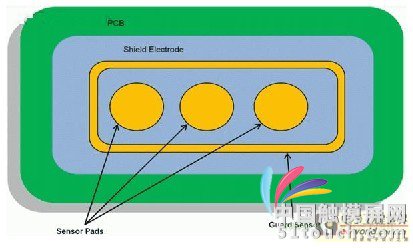Capacitive touch sensing technology in household appliances
Time:2023-04-26
Views:1083
【 Introduction 】: The buttons based on capacitive sensing technology make the appearance of electrical appliances fashionable and beautiful, eliminating wear issues, and are more popular compared to mechanical buttons. Many electrical appliances need to be used in environments close to liquids, so waterproof function should be considered to avoid incorrect button triggering caused by water splashing. Figure 2 shows a typical layout of a printed circuit board (PCB) for capacitive sensors. Protection can be achieved by connecting protective electrodes


Due to the fact that many of the components required to build the system are now integrated into a unified chip, SoC can significantly accelerate the product launch process. In addition, the time required to connect multiple devices and debug faults can also be significantly reduced.
Figure 1 shows the block diagram of the induction cooker. This electrical appliance must provide the following key functions:
Maintain the temperature of the pan: Pulse Width Modulation (PWM) is required to set the ignition duration of the heating coil;
Fan control: requires temperature sensors and PWM to drive the fan motor;
● Overcurrent and overvoltage protection: ADC and comparator required;
Automatic detection of pan: requires inductance sensing function;
● Time based cooking function: requires real-time clock (RTC);
● User interface - display screen: requires LED driver or LCD glass display screen;
User interface - buttons: capacitive touch sensing and detection functions are required.

Capacitive induction technology
The buttons based on capacitive sensing technology make the appearance of electrical appliances fashionable and beautiful, eliminating wear issues, and are more popular compared to mechanical buttons. Many electrical appliances need to be used in environments close to liquids, so waterproof function should be considered to avoid incorrect button triggering caused by water splashing. Figure 2 shows a typical layout of a printed circuit board (PCB) for capacitive sensors. Waterproofing can be achieved by connecting protective electrodes instead of grounding the shaded area (blue) around the sensor.

Figure 2. Using protective electrodes to achieve waterproof function
The signal driving this electrode is the same as the signal connected to the sensor, so when water droplets drop on the sensor, there will be no potential difference between the shadow area and the sensor. The sensor will not be coupled with more capacitors, thus achieving a waterproof effect. If the sensor is completely submerged in water, a protection mechanism will be activated to disable the sensor‘s operation.
Due to the high current required for many electrical appliances, power supplies typically generate significant noise/ripple due to changes in load current and digital switches. Digital switches are also coupled to capacitive sensors, thereby affecting the reliability of the user interface. According to the correct schematic diagram and layout guide, we can reduce the ripple in the power supply through ground wire layout and other technologies to ensure that there is no ground bounce. However, it is difficult for us to completely remove noise. If the+ve line of the power supply is used to drive the reference, there may be a false alarm of capacitive induction.
By switching sensors between GND and VREF (internally generated), any change in power supply will not trigger an error as long as it is within the specified product operating limits.
Higher integration and lower costs
SoC has integrated on-chip peripherals and hardware based features, which can help designers implement most or even all electrical functions.
In today‘s fiercely competitive consumer market, electrical appliances must have rich characteristics. Integrated SoC not only integrates more and more application features, but also reduces overall system costs, making it the best choice for OEM manufacturers. This method is also applicable to small appliances such as induction cookers and microwaves, as well as large appliances such as washing machines and refrigerators (of course, large appliances still require specialized control for specific functions such as FOC motor control).
|
Disclaimer: This article is transferred from other platforms and does not represent the views and positions of this site. If there is any infringement or objection, please contact us to delete it. thank you! |











